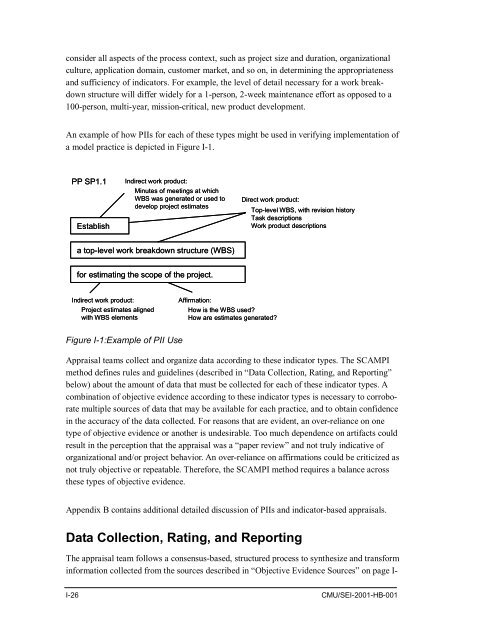Standard CMMI Appraisal Method for Process Improvement (SCAMPI)
Standard CMMI Appraisal Method for Process Improvement (SCAMPI)
Standard CMMI Appraisal Method for Process Improvement (SCAMPI)
You also want an ePaper? Increase the reach of your titles
YUMPU automatically turns print PDFs into web optimized ePapers that Google loves.
consider all aspects of the process context, such as project size and duration, organizational<br />
culture, application domain, customer market, and so on, in determining the appropriateness<br />
and sufficiency of indicators. For example, the level of detail necessary <strong>for</strong> a work breakdown<br />
structure will differ widely <strong>for</strong> a 1-person, 2-week maintenance ef<strong>for</strong>t as opposed to a<br />
100-person, multi-year, mission-critical, new product development.<br />
An example of how PIIs <strong>for</strong> each of these types might be used in verifying implementation of<br />
a model practice is depicted in Figure I-1.<br />
PP SP1.1<br />
Establish<br />
Indirect work product:<br />
Minutes of meetings at which<br />
WBS was generated or used to<br />
develop project estimates<br />
Direct work product:<br />
Top-level WBS, with revision history<br />
Task descriptions<br />
Work product descriptions<br />
a top-level work breakdown structure (WBS)<br />
<strong>for</strong> estimating the scope of the project.<br />
Indirect work product:<br />
Project estimates aligned<br />
with WBS elements<br />
Affirmation:<br />
How is the WBS used?<br />
How are estimates generated?<br />
Figure I-1:Example of PII Use<br />
<strong>Appraisal</strong> teams collect and organize data according to these indicator types. The <strong>SCAMPI</strong><br />
method defines rules and guidelines (described in “Data Collection, Rating, and Reporting”<br />
below) about the amount of data that must be collected <strong>for</strong> each of these indicator types. A<br />
combination of objective evidence according to these indicator types is necessary to corroborate<br />
multiple sources of data that may be available <strong>for</strong> each practice, and to obtain confidence<br />
in the accuracy of the data collected. For reasons that are evident, an over-reliance on one<br />
type of objective evidence or another is undesirable. Too much dependence on artifacts could<br />
result in the perception that the appraisal was a “paper review” and not truly indicative of<br />
organizational and/or project behavior. An over-reliance on affirmations could be criticized as<br />
not truly objective or repeatable. There<strong>for</strong>e, the <strong>SCAMPI</strong> method requires a balance across<br />
these types of objective evidence.<br />
Appendix B contains additional detailed discussion of PIIs and indicator-based appraisals.<br />
Data Collection, Rating, and Reporting<br />
The appraisal team follows a consensus-based, structured process to synthesize and trans<strong>for</strong>m<br />
in<strong>for</strong>mation collected from the sources described in “Objective Evidence Sources” on page I-<br />
I-26 CMU/SEI-2001-HB-001
















